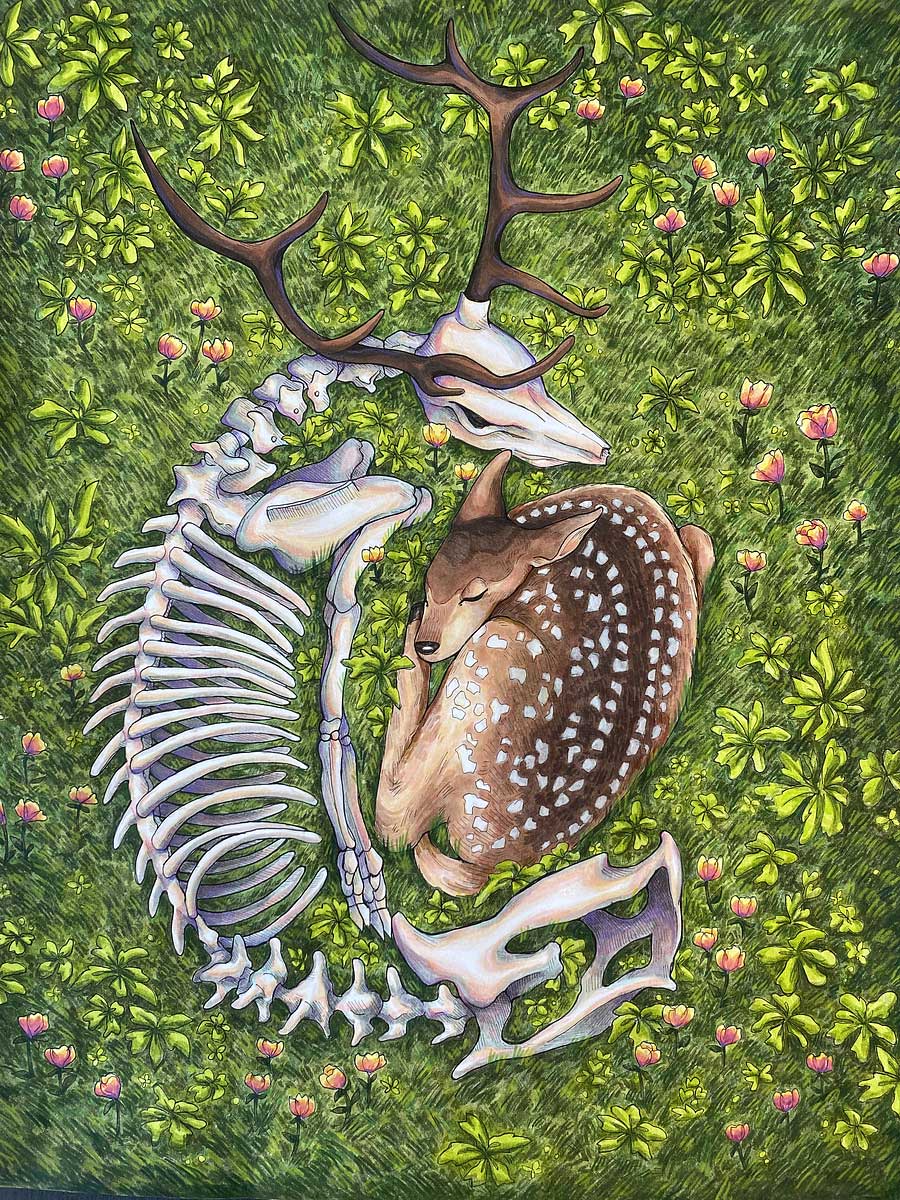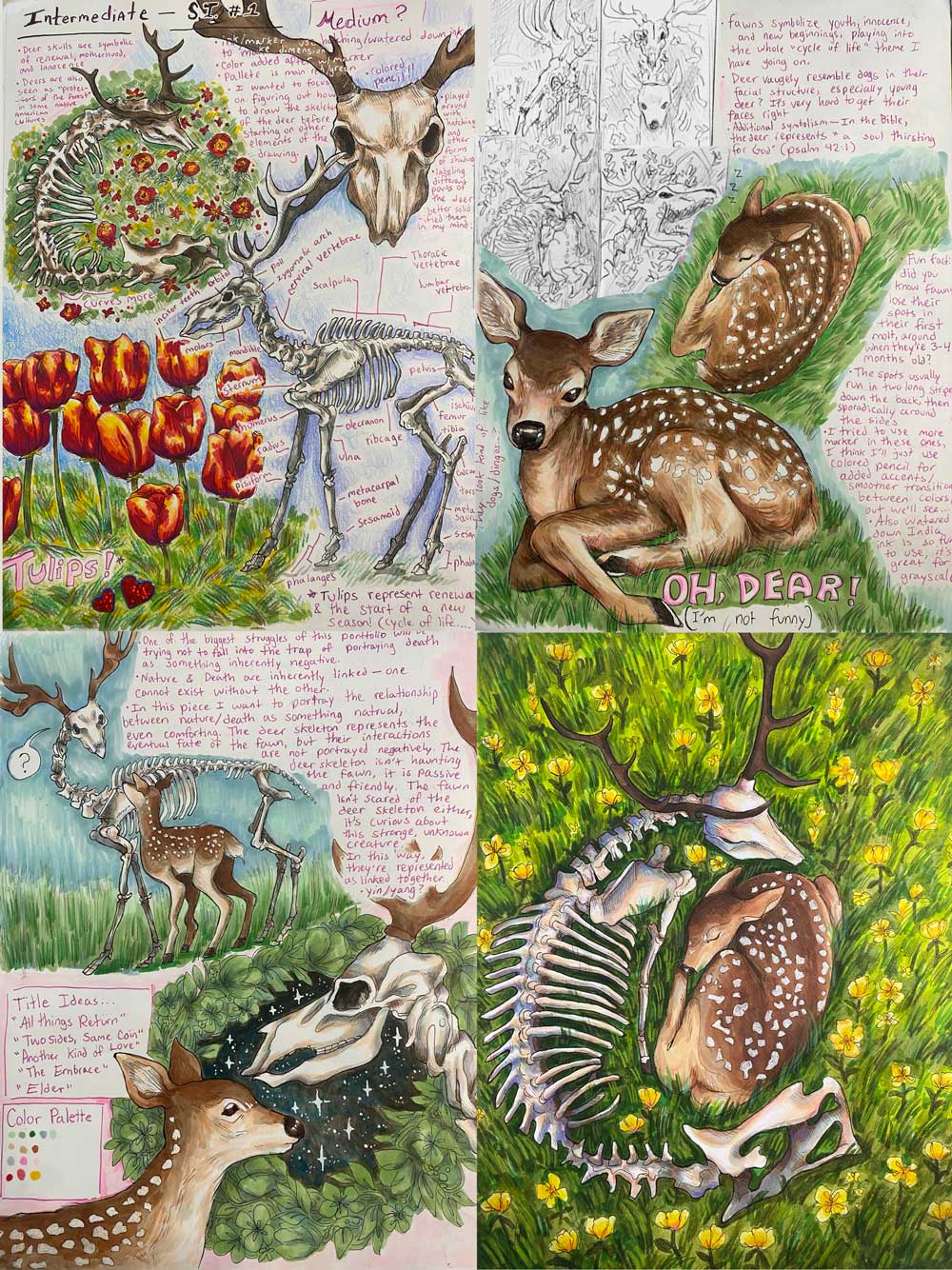

Acceptance

Height: 18” x Width: 14” | Idea(s): Deer are associated with innocence; this work alludes to the death of innocence and accepting it. | Material(s): I inked my sketch, colored with alcoholic and watercolor markers, and then added colored pencil. | Process(es): I inked my sketch, colored with alcoholic and watercolor markers, and then added colored pencil. | Curatorial Note: Powerful illustration about the duality of life and death, beautifully rendered. The student has an excellent command of the media, color, and composition.
Alison "Ajax" Holmer
What did you do to improve your 2-D, 3-D, or Drawing portfolio skills?
To improve my 2-D skills, I filled my sketchbooks with ink drawings. I would draw in pen, Sharpie, marker, colored pencil—any material that can’t easily be erased or changed. I’ve found that the quickest way for me to improve is to sketch with an unforgiving material like ink. I can’t get caught up on imperfections, and I can’t erase my lines over and over again to make them look “good.”
Does your work reference or draw on a contemporary or historical art-making style, practice, or tradition? If so, please explain.
My style is very illustrative and organic, typically focusing on nature as a subject matter. My work doesn’t intentionally reference any previous artistic movements or themes.

What is the relationship between nature and death? The natural process of decay had always interested me from an artistic standpoint. I decided to push the concept further, developing it into a full-fledged question. How could I represent the symbiotic, intertwined nature of the two concepts? To ground my idea, animals would be the main focus of each piece. Their interactions would serve as the "answers" to the inquiry.
In what ways did your art-making confidence increase in AP Art and Design?
Before taking AP 2-D Design, I had never attempted to create a portfolio centered around a single theme. But by taking this class and allowing myself to explore different ideas, I’ve found that the concept of nature and death really fascinates me from an illustrative standpoint. I view the relationship between these two forces as a complex, cyclical experience, and translating that idea into my artwork fueled my inspiration through this course and beyond. In “Acceptance,” I wanted to capture a feeling of loss, but also comfort and reminiscence. Death may have claimed the life of the deer, but its life is celebrated through the fawn’s memory. I didn’t want to portray death as something inherently negative, but rather a force that coexists with nature in harmony.
How did your classmates help you in the creative process?
While taking AP 2-D Design, I found that having another set of eyes on my work helped me greatly with my planning process. Peer feedback was especially helpful in the thumbnail stage, when I was still figuring out the layout of my piece and wanted a composition that would read clearly to my audience. Additionally, being surrounded by other creatives who supported and encouraged my work really helped with my motivation and inspiration.
Did you participate in art shows at your school or in your community?
“Acceptance” was also displayed in the Rhode Island Art Education Association’s annual student art showcase. During the showcase, multiple people approached me to tell me that it generated a very emotional, heartfelt response in them. Its imagery of grief and reminiscence hit close to home for those who had also lost someone close to them. I’m incredibly grateful to these people for sharing their experience with me, and glad that “Acceptance” touched them in such a meaningful way.

Doreen Lindenburg
Barrington High School, Barrington, RI, USA
Teacher Statement
Teacher Statement
The AP Art and Design course supports inquiry-based personalized learning in the sustained investigation portfolio component. What strategies helped you guide students through inquiry?
Students were given a generous amount of time to explore and discuss their essential question ideas. They were allowed to work through several ideas independently through a variety of critiques, discussions, and trial and error.
How did you scaffold writing into the art-making and thinking processes?
I asked students to include writing in each sketchbook entry. Students' thoughts and ideas should be expressed through the written word as well as through their art. Combining writing with visual recording of ideas helped them work through and process thoughts and ideas more comprehensively.
How did you support skill development AND inquiry in the AP Art and Design curriculum?
Students are focused on sketchbook entries and ideas, allowing room for experimentation and skill development. Students participate in class critiques with the teacher and their peers, allowing for revisions and inquiry into their technical processes, thought processes, and implementation of their final vision.

Idea(s): Deer are associated with innocence; this work alludes to the death of innocence and accepting it. | Material(s): Watercolor marker, alcoholic marker, and ink on drawing paper. Collage was made digitally. | Process(es): I sketched, inked, and colored with watercolor and alcoholic marker. I compiled the pages digitally.
How did you structure practice, experimentation, and revision into your AP Art and Design curriculum?
This is my tenth year teaching AP art studio. I began the course following the guidelines and calendar, hoping to make time and space for each student to delve into their ideas and create a portfolio as comfortably as possible without feeling pressured by deadlines. That said, we did have regular critiques for both process work and final pieces, which helped students in terms of ideas and growth. I revised the approaches towards outcome-based art, and over the years allowed students to explore and grow in ways that suited that specific student best. I focused more on the process itself and the work and revisions in their sketchbooks. All students are allowed to experiment in almost any subject area and any technique within the two-dimensional guidelines.
How do you support your students in the Selected Works portfolio component?
I am familiar with my students' work over the years and have helped them choose their best pieces for college applications and other contests throughout the years.
What formative and summative assessments helped guide your students through your AP Art and Design curriculum?
We are able to look at ideas and work created over the course of the summer and compare them to the growth the students experience when they are making art on a regular basis during AP studio. The ability to share with peers and work consistently fosters a great deal of growth with the students.
What creative programming (i.e., exhibit spaces, mentoring programs, curricular supports) have you implemented to support AP Art and Design students?
Students exhibit their work continually in various locations within the school. Last year the students were in a floral and art exhibit in conjunction with the local floral town club. They had a spectacular exhibit at the local library, which was featured in the town newspaper and had a formal opening reception. Other students show their work around the area in student-based shows. The students leave the high school very familiar with showing their work on a regular basis. Additionally, my classroom is always open, and students are in my room working during their free periods and lunches. I have an open-studio policy.
What did you learn from working with your student?
What is interesting about Ajax (Alison) Holmer is that typically students who take my AP studio class are required to have already taken a Drawing 1 course and a Drawing/Painting 2 course. Ajax did not take either of those courses, but we let her come into AP Art Studio. She taught me a big lesson about allowing students without formal training within our building to come in and explore their creative vision. Ajax has changed how I feel about prerequisites moving forward!!
Chris Ashley
Principal
Barrington High School, Barrington, RI, USA
Teacher Statement
Teacher Statement
What are you most proud of regarding your school’s AP Art and Design program, student, and teacher?
We are most proud of our incredibly hard working students and teachers. Their collective commitment to excellence and high standards is inspiring for all students at Barrington High School!
What do you do to support visual arts programming in your school?
As principal, I work to ensure our Arts programming has the critical resources they need to ensure our teachers and students can teach and work at the highest level.
What is your advice to other school leaders on how to support an AP Art and Design program?
Continue to advocate and support your Arts programming through the budget process and showcasing the amazing work of your students.

Alison "Ajax" Holmer



